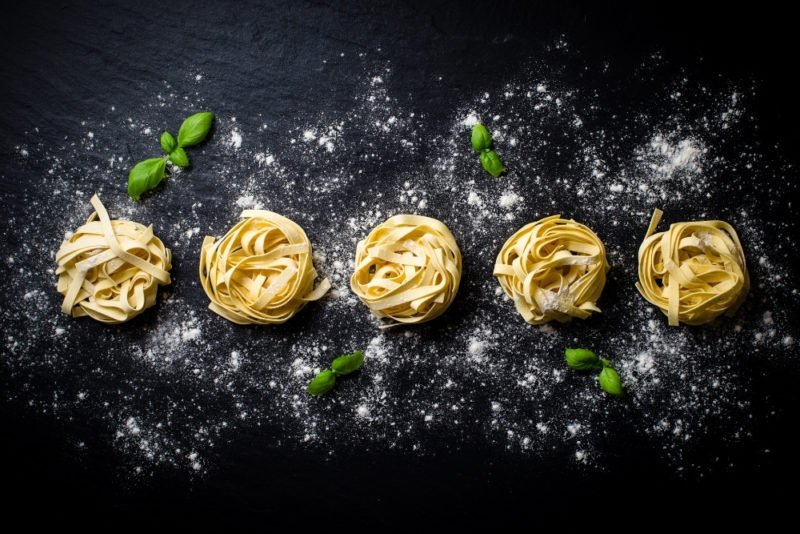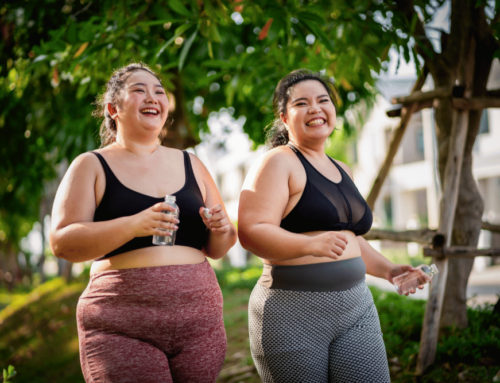
There have been oodles of headlines the past few weeks about a new paper espousing the carbohydrate-insulin model (or CIM) of “obesity.” CIM claims that overeating isn’t the main cause of “obesity.” Instead, it says that carbs are responsible for weight gain. Specifically, it says that excessive consumption of processed, rapidly digestible carbohydrate foods causes changes in the body that drive fat storage, weight gain, and obesity.
Specifically, CIM says that when we eat highly processed carbohydrates, the body secretes more insulin and less glucagon. Insulin is the hormone that keeps our blood glucose (blood sugar) from getting too high. Glucagon is the hormone that keeps it from getting too low.
High insulin and low glucagon means more glucose is stored in fat cells signals fat cells, leaving less glucose available in the blood to fuel muscles and other metabolically active tissues. The brain perceives that the body isn’t getting enough energy (the brain needs a lot of glucose), which leads to feelings of hunger. Plus, the body may slow down its metabolism in an attempt to conserve fuel. The theoretical result? We remain hungry even as we continue to gain excess fat.
It’s worth pointing out that this paper is a perspective piece. It’s not a randomized controlled trial. It proves nothing (to the extent that any study can truly prove anything).
The authors propose that their model replace the century-old “calories in, calories out” model, which posits that we gain weight when we eat more and/or move less, and lose weight when we eat less and/or move more.
The carbohydrate-insulin model isn’t new — it’s actually been around for about a century. But it’s picked up steam in the last 15 years ago, from actual researchers, non-scientist authors, and bro podcasters.
Here’s what else you need to know.

Calories in, calories out is already on the way out
The paper makes it sound like scientists still believe in calories in, calories out, or CICO as I’ll call it henceforth. It’s true that CICO is unfortunately still invoked in countless diet plans, public health anti-obesity campaigns, and even in the Dietary Guidelines for Americans. But the CICO model has been fading away in scientific circles over the past few decades. And recent “obesity” guidelines from the Canadian Medical Association call for moving away from the tired “eat less, move more” recommendations.
That’s a good thing, because CICO is rubbish. It basically tries to apply physics to complex biological creatures. If all humans had to do to lose weight and keep it off was eat less and move more, I guess we would all be in smaller bodies.
But there is another widely supported model within the scientific community, and that model acknowledges that many factors influence how much body fat we have.
- Broad factors include interactions between genetics, epigenetics, life events, and our environment.
- More specific factors, include, yes, how much we move and what/how much we eat, but also brain circuits that regulate food intake (this includes appetite and satiety hormones), exposure to endocrine-disrupting chemicals such as PFCs and BPA, the gut microbiota, social and economic factors (this could include things like stress, trauma, poverty, access to safe and walkable neighborhoods).
So, super complex, as reflected in the image above.

Not all carbs are the devil
The carbohydrate-insulin model targets processed carbs, which we do digest and absorb more rapidly so, yes, can cause spikes in blood sugar which can also increase insulin secretion. Totally true. This is of course more of an issue for people who have fasting blood sugar levels that are higher than normal, but eating a lot of “fast carbs” isn’t a truly satisfying way to eat for anyone, regardless of their health status.
Why? Because you’re likely to have less-stable energy levels and will probably get hungry soon after you’ve eaten. That’s why I recommend that my clients eat “mixed” meals and snacks — in other words, pair carbohydrate-rich foods with foods containing protein and fat. This slows down digestion and absorption.
One example would be a stir-fry with rice, veggies, protein (chicken, beef, shrimp, tofu or tempeh) and some fat from sesame oil and maybe some cashews or peanuts sprinkled on top. Another would be fish tacos with veggies and sliced avocado. Another would be adding nuts to your bowl of oatmeal, or having your mid-afternoon fruit snack with some nuts or a little cheese.
There’s a place for processed carbs (a category that includes many desserts and packaged snack foods) as “fun foods,” but including more nutrient- and fiber-rich carbs (whole grains, fruit, vegetables, beans) helps us improve the quality of our diets and can help us simply feel better. This can be done in an experimental way rather than a rigid, rules-based way.
(I will note that the paper recommends continuing to include moderate amounts of high-quality carbs, but it is very much in a joyless, rules-based, and dare I say fear-based, way)

Not all people respond to carbs the same
There is good scientific evidence that making most of our carbs quality carbs is good for our health. However, when it comes to the idea of restricting carbs, that’s simply not right for everyone. The DIETFITS Study is one study that elegantly demonstrates that fact.
Researchers randomly assigned 609 healthy men and women ages 18 to 50 to either a low-fat or a low-carb diet. They spent eight weeks going as low as possible with fat or carbs—20 grams was the goal—then stayed there for a few more weeks. After that, they gradually increased fat or carbs until they reached a point where they were still “low,” but felt they could be satisfied eating that way long after the 12-month study was over.
- The low-carb group was encouraged to eat foods like avocados, nuts and seeds, pasture-raised eggs, sustainable fish and grass-fed beef.
- The low-fat group leaned towards whole grains, beans and lentils, seasonal fruit, lean meat and low-fat dairy.
- A common denominator for all was abundant vegetables and fresh salads.
The researchers hypothesized that who did well on each diet would depend on insulin levels and genotype—did they have a gene pattern that could affect how they metabolize fat or carbs? But when the big reveal came, neither one mattered. Within each group, there were huge variations in weight loss—some individuals lost significant weight, while others gained weight. The average weight loss for each group was the same and there was no significant interaction between assigned diet and genotype or insulin levels.
It’s an attractive idea that if we eat the “right” foods we can lose weight or avoid weight gain, but that’s just not so. If it was, science would have latched onto it and there would be scientific consensus.

Hello, fat phobia
As with most research studies and articles about “obesity,” the CIM is mired in weight stigma. It implies that all people in large bodies need to be “fixed,” and that following their instructions will lead to a lasting fix.
It also implies that everyone who is in a fat body (I use fat as a neutral descriptor, like “tall” or “brown-eyed”) has insulin resistance, which is absolutely not the case. Some people are able to store more body fat without triggering any health issues.
Even if the CIM model was partly true (i.e., if eating “too many” processed carbs is what’s driving this bus), it’s still ignoring all the contributing factors to “obesity” shown in the diagram above. And it assumes that cutting out processed carbs will make everyone (or at least most people) thin.
And if someone does has insulin resistance, which often happens when someone is on the road to developing type 2 diabetes, there are many ways to address that without turning to dieting and counting macros in the pursuit of weight loss.
- Stress reduction (elevated levels of the stress hormone cortisol can mess with insulin levels)
- Regular, enjoyable physical activity (using our muscles helps prevent or reduce insulin resistance)
- Getting enough sleep (poor sleep quality is associated with an increase in insulin resistance) and treating sleep apnea, if that’s a concern
- Eating balanced, mixed meals with high-quality carbs (as discussed above)
- Learning to eat in tune with natural hunger and fullness levels
The bottom line is that research has not been able to identify a safe method of permanent weight loss. So why not focus on how we can shift our food choices and our lifestyle habits in a way that helps us feel better every day while supporting our long-term health. These changes have real value regardless of what someone weighs.
And because health is not all about “personal choices,” we need to see systemic change around income equality, healthcare access, healthier and safer neighborhoods, and an ending of discrimination based on race, sex, gender, body size and so on. Yes, that’s the hard part.
The bottom line
When the media jumps all over a scientific theory, it’s easy to feel like you should try to apply it to yourself. Or, if the horse has already left the barn, so to speak (i.e., you are already in a larger body), you might feel guilt that you “did this to yourself” by eating “too many” processed carbs. Please, take a breath, and if you remember only two things from this post, make it these: 1) the CIM is just a theory, not established fact, and 2) many, many, many factors influence body weight (scroll up and look at that diagram again).
Carrie Dennett, MPH, RDN, is a Pacific Northwest-based registered dietitian nutritionist, journalist, intuitive eating counselor, author, and speaker. Her superpowers include busting nutrition myths and empowering women and men to feel better in their bodies and make food choices that support pleasure, nutrition and health. This post is for informational purposes only and does not constitute individualized nutrition or medical advice.
Seeking 1-on-1 nutrition counseling? Learn more about her Food & Body, IBS management, and nutrition counseling programs, and book an intro call to see if the program is a good fit, and if we’re a good fit!
Want exclusive content on nutrition, health, diet culture and more, plus critiques of nutrition and health journalism? Subscribe to my Food Noise newsletter! 📣
 Print This Post
Print This Post






